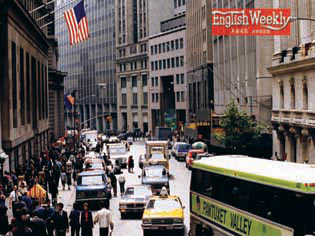| Americans commute longer |
| http://www.sina.com.cn 2006/10/31 22:18 英语周报大学版 |
 Americans commute longer Americans commute longer, farther than ever By Ellen Wulfhorst 郑睿/译 Dave Givens drives 370 miles to work and back every day and considers his seven-hour commute the best answer to balancing his work with his personal life. The winner of a nationwide contest to find the commuter, with the longest trek, Givens is one of millions of people who are commuting longer and farther than ever before. Studies show Americans spend more time than ever commuting, and for a growing number, getting to work takes more than an hour. In the most recent U.S. Census Bureau study, 2.8 million people have so-called extreme commutes, topping 90 minutes. Givens, a 46-year-old electrical engineer, has an extreme commute between home in Mariposa, California, and his job in San Jose. He leaves home before dawn and returns after dark. His trip landed him first place among almost 3,000 entries in the search for America’s longest commute, sponsored by automotive services provider Midas Inc. and announced last week. But as harrowing or tedious as Givens’ trip may sound, he says it’s the way to keep the home and job he loves. “I have the balance right now,” Givens said. “I could do similar jobs closer, but not with the work reward and job satisfaction I have. And I could live closer, but I wouldn’t have the lifestyle that I desire. “To me, this is not that long a commute,” he added. “It’s just something I do to go to work.” Suburb-to-suburb commuting Longer commutes frequently involve people who live in one suburb and work in another, said Alan Pisarski, author of “Commuting in America.” Such a pattern tends to begin with companies moving out of a city to a suburb, enticing workers to move to less-expensive outer suburbs, he said. “People see this as an opportunity to go farther away,”he said. Such a move may provide more affordable housing or better schools. Even high fuel costs — Givens spends about $185 a week on gasoline — can pay off in a better quality of life, Pisarski said. Doreen DeJesus rides a bus from her home in Tobyhanna, Pennsylvania, across New Jersey to her job in Manhattan. The payoff is a house in the country, she said. “It’s a matter of getting away from the hustle and bustle of the city,” said DeJesus, 37. “It’s not an easy thing, but most days it’s really worth it. “My boss thinks I’m nuts6,” she added. Studies show 7.6 percent of U.S. commuters traveled more than an hour to work in 2004, the most recent data available, up from 6 percent in 1990. The average one-way commute grew by 13 percent to 25.5 minutes between 1990 and 2000. In 1990, only in New York state did more than 10 percent of workers spend more than an hour to get to work, Pisarski said. Now that situation can be found in New Jersey, Maryland, Illinois and California as well, he said. Congestion worsens Added to long commutes is increased congestion, according to the Texas Transportation Institute’s 2005 Urban Mobility Report. Commuters typically spent 47 hours a year in traffic jams, up from 40 hours a decade earlier, the study showed. “That’s the time wasted above and beyond just being able to make the trip,” said David Schrank, co-author of the report. But the trips can be worthwhile, said Kay Phillips who works in Chapel Hill, North Carolina, 164 miles from her home in Granite Falls. “I really love what I do, so I don’t mind,” she said. While Givens spends much of his commute listening to the radio, especially traffic reports, Philips, 52, uses her five-hour commute in her own way — she prays. “I say a long prayer starting out every morning for everybody, and it gives you quite a bit of time to do that,” she said. |
| 美国人上下班往返时间更长、距离更远 |
参考译文: 美国人上下班往返时间更长、距离更远 戴夫-吉文斯每天上下班要开车370英里,他认为7个小时的上下班往返时间是平衡其工作与个人生活的最佳答案。 吉文斯在全国上下班最长旅行竞赛中获得冠军。数百万美国人的上下班往返时间比以前更长、距离更远,吉文斯就是其中一员。 研究显示,美国人花在上下班往返的时间比以往任何时候都长,越来越多的人上班需要花1个多小时。最近美国人口调查局研究显示,280万人有所谓极端上下班往返经历,时间长达90分钟。 46岁的吉文斯是一名电气工程师,其上下班极端旅程是往返于加利福尼亚州马里波萨的家与位于圣何塞的工作单位之间。他每天日出前离家,天黑后回家。 他的旅程使其在近三千名最长通通者的搜索活动中名列第一。该搜索活动由汽车服务商弥达斯有限公司主办,搜索结果于上周公布。尽管吉文斯的旅程听上去让人心痛或单调乏味,他说这是保持自己所爱的家庭与工作的方法。 “现在我达到了平衡,” 吉文斯说,“我能够在家附近找到类似的工作,但是达不到目前的报酬和满意度。我也可以住得近一些,但是得不到我想要的生活方式。” “对我而言,这并不是一个长途旅程,” 他补充说,“这只是上班要做的一件事情而已。” 上下班往返于郊区与郊区之间 上下班往返时间较长的人通常居住在一个郊区,而工作则在另一个郊区,《上下班往返在美国》一书作者艾伦-皮萨斯基说。 他说,此类模式往往开始于公司从城市迁至郊区,诱使职工也搬迁至较为便宜的远郊。“我们视此为走得更远的机会。” 皮萨斯基说,这样的迁移可以提供更能负担得起的住房或者更加良好的学校教育。即使是高燃油成本(吉文斯每周的汽油花费约为185美元),这对于更好的生活质量而言也是值得的。 多琳-德吉泽斯从宾夕法尼亚州托比汉纳的家乘巴士穿越新泽西到曼哈顿去上班。 她说,这样做的回报是一所乡村住宅。 “这是一种远离城市拥挤和喧嚣的方法,”37岁的德吉泽斯说,“这确实不是件容易的事,但是大多数日子里,它是值得的。” “我老板认为我是发疯了,”她又说。 研究显示,2004年,7.6%的美国上班族花1个多小时去上班,这是最新得到的数据,这比1990年的数据上升了6个百分点。从1990年到2000年,平均单程上班时间上升了13%,达25.5分钟。 皮萨斯基说,在1990年,只有纽约州有超过10%的上班族需要花1个多小时去上班。现在,这种情况也出现在新泽西、马里兰、伊利诺斯以及加里福尼亚。 交通拥堵恶化 根据《德克萨斯州交通协会2005年度城市流动报告》,与长时间上下班时间相伴出现的是加剧的交通拥堵状况。该研究显示,上班族通常每年花在交通拥堵的时间由10年前的40小时上升到现在的47小时。 “这是浪费了的时间,超出了旅程时间的承受范围,”报告的合著人戴维-施兰克说。 但是旅途可算是非常值得的,凯-菲利普斯如是说,她在北卡罗莱纳州的查珀尔-希尔工作,距她在格拉尼特-福尔斯的家有164英里。 “我真的喜欢这么做,所以我并不介意,”她说。 当吉文斯花费大部分上下班时间在收听电台节目上,特别是交通报告上时,52岁的菲利普斯则以她自己的方式在5小时的上下班时间里进行祈祷。 她说:“从每天早上开始,我就为每个人长时间祈祷,而这给了你足够的时间去做这些事情。” |
| 【发表评论】 |
|
|
| 【评论】【论坛】【收藏此页】【大 中 小】【多种方式看新闻】【下载点点通】【打印】【关闭】 |